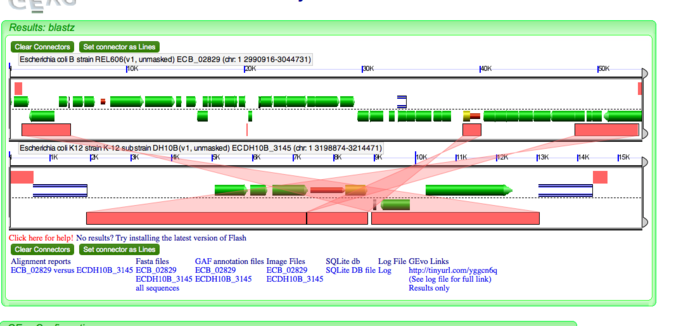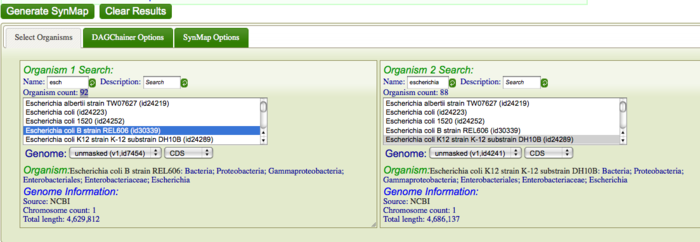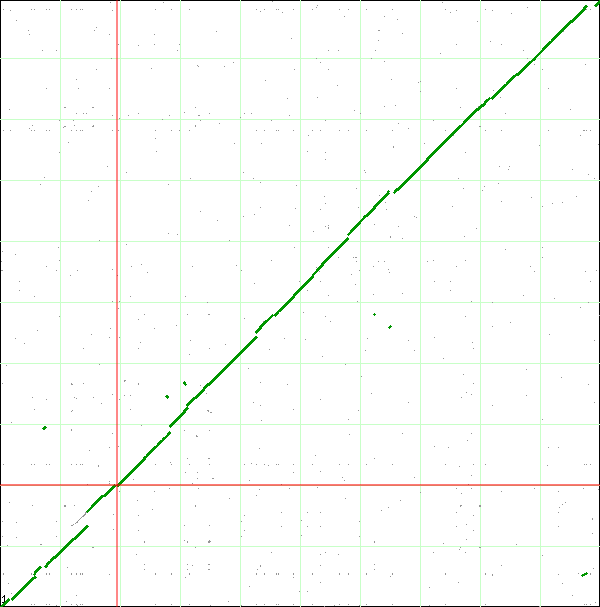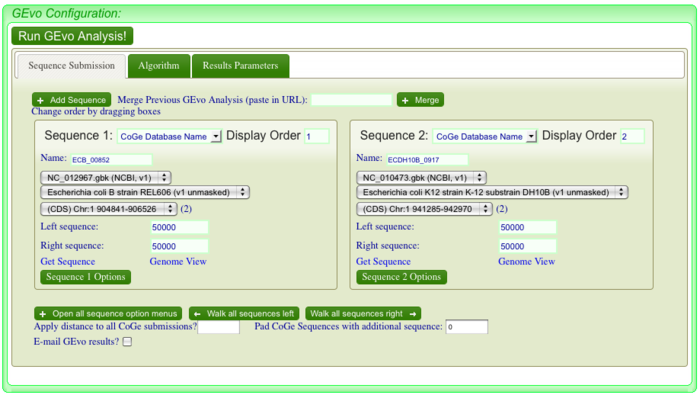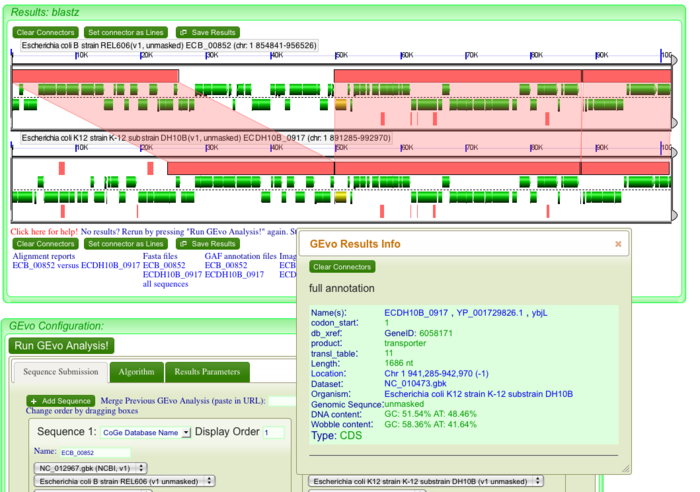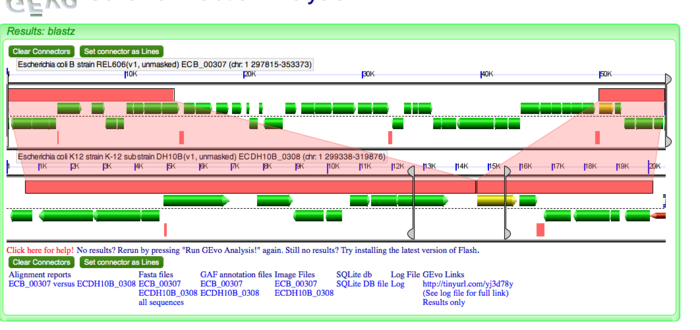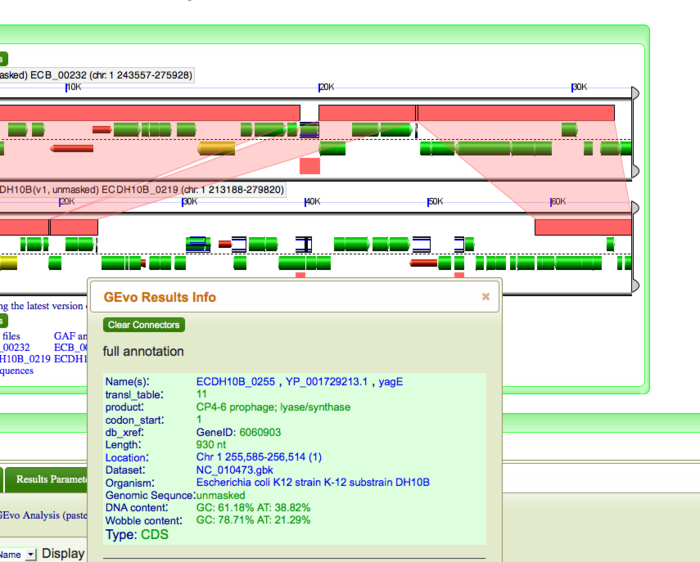Analysis of variations found in genomes of Escherichia coli strain K12 DH10B and strain B REL606 using SynMap and GEvo analysis
In this exercise you will compare the genomes of two Escherichia coli strains, K12 DH10B and B REL606, using whole genome syntenic comparison and high-resolution analyses of specific genomic regions. These analyses will use CoGe's tools SynMap and GEvo respectively, and will reveal evolutionary changes between these two genomes that happened after the divergence of their lineages. While the nucleotide sequence of these genomes is identical over large expanses of their genomes, many other types of large-scale genomic change will be discovered including phage insertions, transposon transposition, and genomic insertion, deletion, inversion, and duplication events. The computational tools used to do these analyses can be used for comparing genomes of any organisms.
First, you are going to identify syntenic regions between these genomes. Synteny is defined as two or more genomic regions that share a common ancestry and thus are derived from a common ancestor. To do this, you are going to construct a Syntenic dotplot of K12 DH10B and B REL606 using SynMap. Go to SynMap Search for these E. coli strains in CoGe's database by typing in part of the their names in the "Name" search boxes for Organism 1 and Organism 2. For example, search for "DH10B" and "REL606" respectively, or type "escheri" in both boxes. Once CoGe has found organisms matches these names, make sure they are selected in the Organism List. While there are several parameters that can be configured when generating a syntenic dotplot using SynMap, the default settings work well for most situations, and very well for closely related organisms. Click "Generate SynMap" to start the analysis.
A lot of processing is happening behind the scenes, but the general way a syntenic dotplot is created is the genomes are compared to one another in order to find putative homologous genes between them, and then these pairs of genes are processed to find collinear series of genes in both genomes. The general principle is that the most likely and parsimonious way two genomes have a collinear series of homologous genes is those genomic regions in each organism are derived from a common ancestral genomic region (hence they are syntenic).
When finished, SynMap will display a dotplot. Each axis of the dotplot is in nucleotide units and represents one of the two genomes laid end to end. The lower-left corner represents the start of each genome (usually 'ORI' for circular bacterial genomes), and the end of each axis is the end of each chromosome. Each putative homologous gene-pair is drawn as a gray dot on the dotplot with its position corresponding to the genomic position of each gene in their respective genomes. Gene-pairs that have been identified has being syntenic are colored green. The collection of these dots appear as green line, which for the comparison of these two genomes, in nearly continuous along the entire length of both genomes.
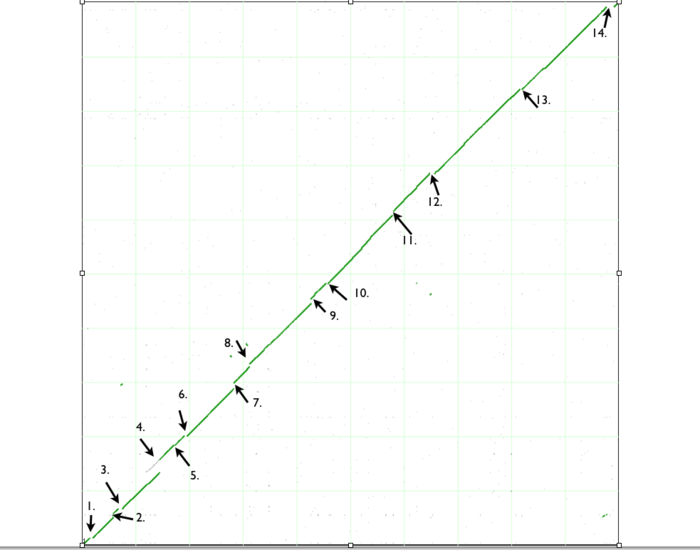
After positioning the locator and clicking , a new page for GEvo will appear displaying the sequence information corresponding to our region of interest in the dotplot. These sequences are "anchor" points into these two genomes for specifying the genomic regions to be compared. When linking to GEvo, SynMap automatically sets GEvo to specify using 50,000 nucleotides to the left and right of the anchor point. By default, GEvo will use BlastZ for its sequence comparison algorithm, which is a good choice for identifying large blocks of similar sequence. These settings (~100kb of each genome; BlastZ) usually work well for an initial analysis, and all you need to do is click "Run GEvo Analysis!".
Once GEvo analysis appears, we can begin to look for and characterize the differences between these two genomes at this syntenic region. GEvo's results will show two panels, one for each genomic region. The dashed line in the middle of each panel separates the top and bottom strands of DNA. Gene models are drawn as green arrows above and below this line, and clicking on a gene will cause its annotation to appear in a box.
The pink blocks in these panels are genomic regions identified by BlastZ as being similar in sequence composition. If you click on a pink block, a transparent wedge is drawn connecting it to its partner region in the other genome, and information about the blast hit (also known as an HSP) is shown in an information box. Similarly, click on all the pink blocks displayed to connect every region of sequence similarities. Since we are analyzing "breaks" in our dotplot, we expect to see insertion(s) and/or deletion(s) in genomes. These indels will be evident by the pattern of transparent wedges and missing pink blocks.
Let us look at an example of deletion in DH10B with no apparent changes in the corresponding region of genome in REL606. This corresponds to the GEvo analysis of the first break in our dotplot. You can regenerate the high resolution analysis here [1]. Click on all the pink blocks as to connect every region of sequence similarity. Note that deletion in DH10B creates a gap between the transparent wedges. Click on individual genes in REL606 to identify which genes are missing in DH10B. We can conclude that this is an example of deletion because of presence of pseudogenes at site of deletion in DH10B. Perhaps transposon(s) insertion created pseudogenes that later got deleted. Remember we are looking at these genomes at a single time point and trying to trace back its history. Based on this fact, we can hypothesize that at some point in past, tranposon(s) had integerated into what is now a site of deletion in DH10B. As we will see that transposition is the most common cause of changes introduced in genomes and so it is most likely that this deletion in DH10B was the result of transposon insertion.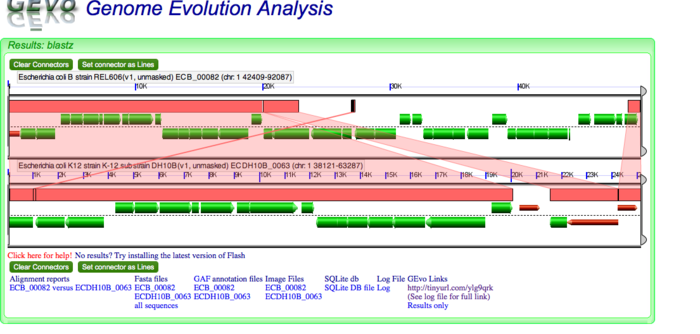

Click on the inserted genes to view their annotations. There is a lac operon and few other metabolic genes. But how can a critical operon be missing from E-coli DH10B? If you go back to our dotplot and align the locator on third break, you will see a fragment of green line right above the break. Position the locator on it and click. GEvo analysis will show that the region of "inserted" genes in REL606 is syntenic to region on a farther locus in DH10B. You will see lac operon and other metabolic genes which are missing in DH10B at third break are present elsewhere on its genome. This is an example of translocation. In this case syntenic regions are not collinear i.e they do not share same locus on a chromosome.
Let us consider the ninth break in the dotplot. Run GEvo Analysis for this break. Magnify the region from 50k to 100k using side bars. Notice that a number of flagella genes are present in DH10B but are missing in REL606. The presence of direct repeats is not evident yet and we cannot conclude that insertion happened in DH10B. We will BLAST DH10B against itself to see any direct repeats. If it is infact, an insertion then we expect to see color coded bars bordering the DNA region containing these flagella genes in DH10B. Click on "Add sequence" and copy and paste the gene ID of DH10B into "name" box in the third sequence. This option allows us to view multiple sequences at the same time. Adjust the number of sequences on left and right to view syntenic regions on all three sequences.These are direct repeats and evidence for insertion in DH10B. Direct repeats allows us to infer that there was a staggered cut in the DNA of DH10B followed by insertion of linear piece of DNA. The gaps at the ends were repaired and ligated. These repaired an ligated gaps became direct repeats that flank the DNA segment containing flagellar genes. Notice that there is not much support that this is a translocation. You can click on several green dots that align with ninth break on our dotplot. These regions are mostly repeats which are syntenic all over the genome and are therefore "noise" in our data.
Next, we will look at phage insertion. Consider the second break in the dotplot. Run GEVo analysis on this break. Before checking for direct repeats, determine the identity of genes inserted in DH10B. These are phage-specific genes. CP4-6 prophage has integrated its DNA at this locus as seen by CP4-6 specific integrase, DNA binding protein etc.Next we will look at an example of inversion. Consider the twelfth break on the dotplot. Run GEvo Analysis on this break. Notice the syntenic regions between 10K and 30K on DH10B. Click on the pink blocks and notice the pattern of transparent wedges that connect the syntenic regions. These genes are inverted. Notice IS10R and IS10L bordering the inverted region. These IS elements have created inverted terminal repeats (ITR) which tend to invert or flip the genes within them.
